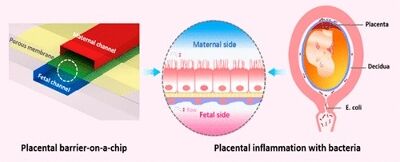A 3D human lung-on-a-chip model for nanotoxicity testing |
We proposed a novel 3D human lung-on-a-chip model to recreate the organ-level structure and functions of human lung that allow to evaluate the pulmonary toxicity of nanoparticles. The lung-on- a-chip consist of three parallel channels for coculture of human vascular endothelial cells and human alveolar epithelial cells sandwiching a layer of Matrigel membrane, which recapitulate the key features of alveolar capillary barrier in human lung. This lung-on-a-chip model indicated its versatile application in human pulmonary health and safety assessment for nanoparticles, environment, food and drugs. |

|
|
Toxicology Research, 2018, 7, 1048-1060 (Cover image) |
Placental Barrier-on-a-Chip: Modeling Placental Inflammatory Responses to Bacterial Infection |
We established a microengineered model of human placental barrier on the chip and investigated the associated inflammatory responses to bacterial infection. The multilayered design of the microdevice mimicked the microscopic structure in the fetal-maternal interfaces of human placenta, and the flow resembled the dynamic environment in the mother’s body. Escherichia coli (E. coli), one of the predominant organisms found in fetal organs, were applied to the maternal side, modeling acute placental inflammation. placental barrier-on-a-chip microdevice presents a simple platform to explore the complicated inflammatory responses in human placenta, and might help our understanding of the mechanisms underlying reproductive diseases. |

|
|
ACS Biomaterials Science & Engineering, 2018, 4 (9) : 3356-3363 |
A Microfluidic Strategy for Controllable Generation of Water-in- Water Droplets as Biocompatible Microcarriers |
A new microfluidic strategy is described for controllable and high- throughput generation of monodispersed water-in-water (W/W) droplets. Solutions of polyethylene glycol and dextran are used as continuous and dispersed phases, respectively, without any organic reagents or surfactants. The size of W/W droplets can be precisely adjusted by changing the flow rate of dispersed and continuous phases and the valve switch cycle. The high-throughput droplet microfluidic system with high biocompatibility is stable, controllable, and flexible, which can boost various chemical and biological applications, such as bio-oriented microparticles synthesizing, microcarriers fabricating, tissue engineering, etc. |

|
|
Small, 2018, 14 (36) : 1801095 |

 Research Interests
>
正文
Research Interests
>
正文